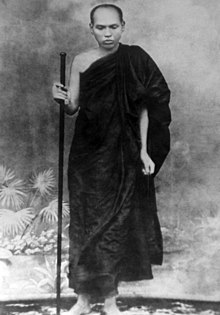Ledi Sayadaw
Ledi Sayadaw U Ñanadhaja (Burmese: လယ်တီဆရာတော် ဦး ဉာဏ ဓ ဇ, [Ledi Sayadaw: "The great scholar from Ledi"]; * December 1, 1846 in Tabayin ; † June 27, 1923 in Pyinmana ) was a Buddhist monk in the Theravada tradition and a influential Buddhist teacher of his time.
overview
He was well versed in theory and practice from a young age and was therefore soon venerated as a scholar and saint. He wrote several books on Buddhist teaching in the Burmese language, which were also understandable for the layman. With this he had revived the teaching and spread it far beyond the class of monks and nuns into society. He placed particular emphasis on explaining and making available the empirical, i.e. the experience-related aspect of Buddhist teaching.
Life
Ledi Sayadaw learned the meditation technique of ("Ledi") Vipassana (an insight meditation that places special emphasis on body sensations) in the caves of the Sagaing Mountains of Burma, where it is still taught. After mastering them, he began to pass them on to others. For this he founded a monastery in the village of Ledi (hence his name), near the city of Monywa . There he meditated and taught most of the time. His main student was the farmer Thet Gyi , with whom a series of lay teachers began, which has continued up to the present day, namely through Ba Khin and his student SN Goenka . Previously, only monks and nuns were taught the technique. At times Ledi Sayadaw traveled all over Myanmar .
In 1885 Ledi Sayadaw wrote the Nwa-myitta-sa (နွား မေတ္တာစာ), a prosaic lesson in which he advocated the avoidance of beef as food. The animals are too valuable as pack animals and workhorses for the Burmese farmer and are threatened with extinction due to the meat consumption. Furthermore, the waiver also makes ecological sense. He later initiated corresponding meat boycotts and inspired an entire generation of independence activists in Burma to adopt this stance in Burma's colonial era, which was still ongoing at the time.
Works
In addition to his writings on Buddhist theory (such as the Manual of Ultimate Truth and The Manuals of Dhamma), his main works also include a book on the grammar of Pali, which makes this language, in which the Buddhist originals were written, accessible to Burmese readers should help. Several of his writings are published today, especially in English, for example by the Buddhist Publication Society and the Vipassana Research Institute.
Individual evidence
- ↑ Charney, Michael (2007). "Demographic Growth, Agricultural Expansion and Livestock in the Lower Chindwin in the Eighteenth and Nineteenth Centuries". In Greg Bankoff, P. Boomgaard. A history of natural resources in Asia: the wealth of nature. MacMillan. pp. 236-40, ISBN 978-1-4039-7736-6 .
| personal data | |
|---|---|
| SURNAME | Sayadaw, Ledi |
| BRIEF DESCRIPTION | buddhist monk |
| DATE OF BIRTH | December 1, 1846 |
| PLACE OF BIRTH | Tabayin |
| DATE OF DEATH | June 27, 1923 |
| Place of death | Pyinmana |
